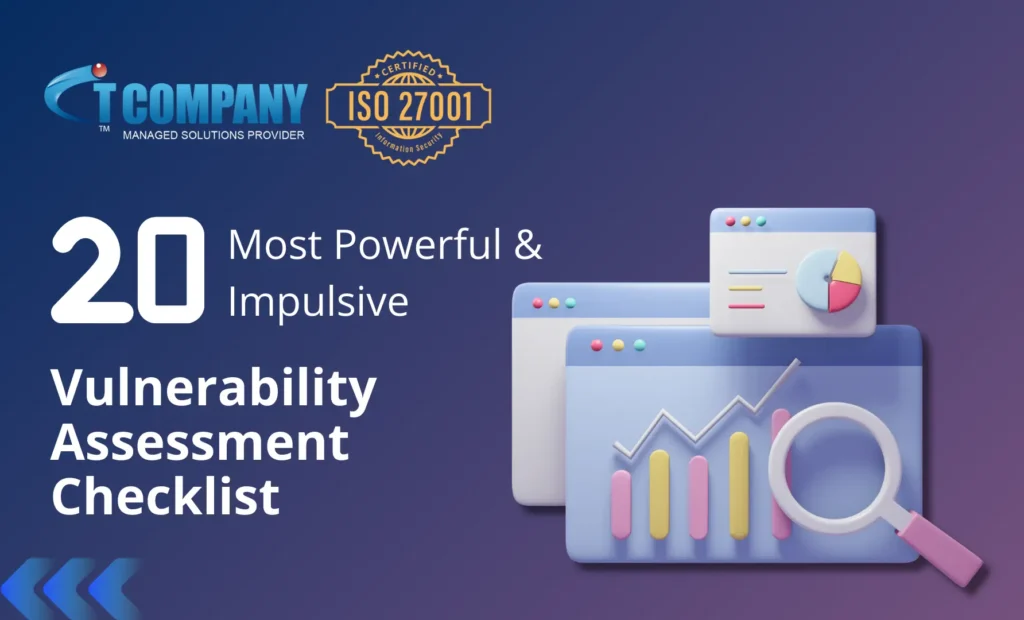
With ISO 27001 certification, IT Company lead the way in providing top-notch security solutions. Our vulnerability assessment checklist identifies critical gaps in your system, helping your organization meet stringent security benchmarks. Let us explore the significance and importance of these one by one.
Table of Contents
ToggleWhy Vulnerability Assessment Checklist is Important for Your Business?
Understanding Vulnerabilities
Vulnerability assessment checklist is crucial as it provides basic insights and fundamental steps in mitigating security risks. Checklists along with vulnerability assessment tools companies can overcome weaknesses in their systems before cybercriminals can exploit them.
For businesses handling payment card information aka PCI vulnerability scan, checklist is very important.
Stay Ahead of Cyber Threats
Every business is vulnerable to cyberattacks and a vulnerability assessment checklists make it sure that all potential entry points are identified in advanced. Reduce the risk of data breaches to save all digital assets and information online. For ecommerce or financial services, conducting a PCI vulnerability scan is not just a recommendation – it is a necessity to maintain customer trust and regulatory compliance.
Compliance and Security Go Hand-in-Hand
In an era where data breaches are becoming increasingly common, vulnerability assessment checklist can be a proactive approach to secure your digital assets. If you are more compliant to international standards like ISO 27001 the more you will be secured, saved and protected.
Proactive Cybersecurity Strategy
checklist helps you build a strong cybersecurity strategy. Regularly conducting checklist procedures enables business to detect and resolve cybersecurity issues, Fix them before escalation.
Boost Customer Trust
In today’s world, customer expectations for data security have reached new heights. They anticipate that their information will be protected at all times, and without a secure connection, they are unlikely to engage with your business. Ultimately, robust security measures are essential for building and maintaining customer trust.
Identify Weaknesses Before Hackers Do
Hackers are constantly seeking new ways to exploit vulnerabilities in business systems. A right vulnerability assessment checklist combined with expert assistance helps in identification and patching process lot smoother and easier.
Regulatory Compliance and Risk Management
For businesses handling sensitive information, regulatory compliance is essential. A vulnerability assessment checklist not only ensures that your business adheres to the latest security protocols but also reduces the risk of non-compliance penalties. The use of vulnerability assessment tools and PCI vulnerability scans provides a solid foundation for maintaining PCI DSS compliance, a crucial aspect for businesses that process payment data.
Safeguard Your Reputation
A single data breach can damage business’s reputation. Implementation using reliable vulnerability scan services can help prevent such occurrences. And regular scanning ensure that your systems are free of critical issues that can potentially hack website and maintain a strong reputation for safeguarding customer data.
Cost-Effective Risk Mitigation
Early vulnerability scanning and check listing is more cost-effective than managing the aftermath of a data breach. As the adage goes, “prevention is better than cure. Investing in proactive security measures helps avoid costly repercussions down the line.
Holistic Approach to Security
A vulnerability assessment checklist provides a holistic approach to securing your business from cyber threats. Integrating vulnerability assessment tools allows for continuous monitoring and early detection of potential security gaps.
10 Most Impulsive Vulnerability Assessment Checklist
- Immediate Patch Updates for Known Vulnerabilities
Promptly apply software patches to address any known vulnerabilities. Delayed updates can leave system exposed to attacks by exploiting weaknesses.
- Urgent Firewall Configuration Review
Regularly review and update firewall configurations to ensure optimal protection. Misconfigurations can create entry points for unauthorized access. -Regularly review and update firewall configurations to ensure enhanced protection.
- Critical Network Security Protocol Audit
Assess the security protocols in your network to identify any outdated or insecure methods. Audit report can reveal weak encryption or other vulnerabilities.
- Immediate Weak Password Identification and Change
Identify and replace weak or compromised passwords across your systems. Enforcing strong passwords reduces the risk of unauthorized access.
- Quick Scan for Unpatched Software
Conduct a rapid scan to detect any software that hasn’t been updated with the latest security patches. Unpatched software is a common entry point for hackers.
- High-Priority Review of Remote Access Controls
Evaluate remote access settings to ensure they follow the best security practices. In work-from home environments are more prone to data breaches via weak or unsecured access points.
- Urgent 2FA Implementation Check
Ensure two-factor authentication (2FA) is implemented across all critical systems. 2FA adds an extra layer of security, making it harder for attackers to gain unauthorized access.
- Rapid Detection of Open Ports and Services
Scan for any open ports or services that should not be accessible. Open ports can be exploited by attackers to infiltrate your network.
- Immediate Removal of Unauthorized Users
Check for and remove any unauthorized users from your systems. Leaving inactive or unauthorized accounts can increase the risk of insider threats or external hacks.
- Critical Backup System Vulnerability Audit
Audit your backup systems to ensure they are secure and not vulnerable to attacks. An insecure backup can become a target for ransomware or data theft.
10 Most Impulsive Vulnerability Assessment Checklist
- Quick Analysis of Malware Protection Status
Review the status of your malware protection tools to ensure they are up to date. Effective malware detection is critical for defending against viruses and ransomware attacks.
- Immediate SSL Certificate Expiry Check
Verify that all SSL certificates are valid and not close to expiring. Expired certificates can lead to data breaches or service disruptions.
- Urgent Review of Email Phishing Defense
Assess the effectiveness of your email filters and phishing defenses. Regular updates are needed to block phishing attacks, which are a common entry point for hackers.
- Rapid Audit of Data Encryption Practices
Quickly evaluate your data encryption protocols to ensure sensitive information is securely protected. Weak encryption increases the risk of data breaches.
- Critical Review of Access Control Policies
Review and tighten access control policies to limit user privileges. Over-permissive access can lead to data leaks or insider threats.
- Immediate Detection of Inactive User Accounts
Detect and Delete unused accounts and disable inactive user accounts. Unauthorized access are one of the reasons that hackers use to exploit data.
- Quick Identification of Shadow IT Systems
Identify any unsanctioned software or hardware in use within your network. Shadow IT can create vulnerabilities by bypassing company-approved security measures and a potential reason to hack a website.
- Urgent Database Security Configuration Review
Review your database security settings to ensure sensitive data is properly protected. Misconfigured databases can lead to data breaches.
- High-Priority Audit of Third-Party Software Risks
Assess third-party software for potential security risks. Many attacks target vulnerabilities in third-party applications integrated into a business’s systems.
- Immediate Check for Misconfigured DNS Settings
Review DNS settings to detect any misconfigurations that could lead to domain hijacking or website hacking. Correct DNS configurations are crucial for secure network operations.
Conclusion
At our IT company, we prioritize comprehensive vulnerability assessment services to protect your business from evolving cyber threats. A thorough vulnerability assessment checklist is critical for identifying and addressing security risks.
Key areas of focus include immediate patch updates, firewall configuration reviews, and network security audits. Our process not only involves identification of weak passwords, scanning for unpatched software, but also securing remote access.
Ensure 2FA implementation, detect open ports, remove unauthorized users, and audit backup systems. Review malware protection, SSL certificates, phishing defenses, encryption practices, and access control policies.
This complete approach safeguards your systems, covering database security, third-party software risks, and DNS settings to prevent vulnerabilities.
